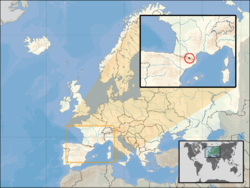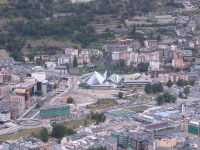Andorra
2008/9 Schools Wikipedia Selection. Related subjects: Europe; European Countries
| Principat d'Andorra Principality of Andorra
|
||||||
|---|---|---|---|---|---|---|
|
||||||
| Motto: "Virtus Unita Fortior" (Latin) "Strength United is Stronger" |
||||||
| Anthem: El Gran Carlemany, Mon Pare ( Catalan) The Great Charlemagne, my Father |
||||||
|
Location of Andorra (circled in inset)
on the European continent (white) — [ Legend] |
||||||
| Capital (and largest city) |
Andorra la Vella |
|||||
| Official languages | Catalan | |||||
| Demonym | Andorran | |||||
| Government | Parliamentary democracy and Co-principality | |||||
| - | French Co-Prince | Nicolas Sarkozy | ||||
| - | Episcopal Co-Prince | Joan Enric Vives Sicília | ||||
| - | Head of Government | Albert Pintat Santolària | ||||
| Independence | ||||||
| - | Paréage | 1278 | ||||
| Area | ||||||
| - | Total | 468 km² ( 193rd) 181 sq mi |
||||
| - | Water (%) | 0 | ||||
| Population | ||||||
| - | 2007 estimate | 71,822 ( 194th) | ||||
| - | 2006 census | 69,150 | ||||
| - | Density | 154/km² ( 69th) 393/sq mi |
||||
| GDP ( PPP) | 2005 estimate | |||||
| - | Total | $2.77 billion ( 177th) | ||||
| - | Per capita | $38,800 ( unranked) | ||||
| Currency | euro (€)1 ( EUR) |
|||||
| Time zone | CET ( UTC+1) | |||||
| - | Summer ( DST) | CEST ( UTC+2) | ||||
| Internet TLD | .ad² | |||||
| Calling code | +376 | |||||
| 1 | Before 1999: French franc and Spanish peseta. Small amounts of Andorran diners (divided into 100 centim) were minted after 1982. | |||||
| 2 | Also .cat, shared with Catalan-speaking territories. | |||||
Andorra, officially the Principality of Andorra ( Catalan: Principat d'Andorra), is a small landlocked country in western Europe, located in the eastern Pyrenees mountains and bordered by Spain and France. Once isolated, it is currently a prosperous country mainly because of tourism and its status as a tax haven. The people of Andorra are currently listed as having the highest human life expectancies on Earth, at an average of 83.5 years at birth (2007 est).
Origin and history of the name
The name "Andorra" is of unknown origin but, according to Joan Coromines, pre-Roman. The name Andorra may be derived from al-Darra (الدّارة), the Arabic word for forest. Many of the local toponyms are of Iberian origin.
History
Tradition holds that Charles the Great (Charlemagne) granted a charter to Andorran people in return for fighting against the Moors. Overlordship of the territory passed to the local count of Urgell and eventually to the bishop of the diocese of Urgell. The Bishop then handed over the territory to the Lord of Caboet. The Caboet family married into the family of the French Count of Foix and through this marriage, the Count inherited all of the Spanish lord's land, including Andorra. In the eleventh century a dispute arose between the bishop and his northern neighbour over Andorra.
The conflict was resolved in 1278 by the signing of a paréage, which provided that Andorra's sovereignty be shared between the count of Foix (whose title would ultimately transfer to the French head of state) and the bishop of La Seu d'Urgell, in Catalonia, Spain. This gave the small principality its territory and political form.
Over the years the title passed to the kings of Navarre. After Henry of Navarre became King Henry IV of France, he issued an edict (1607) that established the head of the French state and the Bishop of Urgell as co-princes of Andorra.
In the period 1812–13, the First French Empire annexed Catalonia and divided it in four départements. Andorra was also annexed and made part of the district of Puigcerdà (département of Sègre).
Andorra declared war on Imperial Germany during World War I but did not actually take part in the fighting. It remained in an official state of belligerency until 1957 as it was not included in the Versailles Peace Treaty.
In 1933 France occupied Andorra as a result of social unrest before elections. On July 12, 1934, an adventurer named Boris Skossyreff issued a proclamation in Urgell, declaring himself Boris I, sovereign prince of Andorra, simultaneously declaring war on the bishop of Urgell. He was arrested by Spanish authorities on July 20 and ultimately expelled from Spain. From 1936 to 1940, a French detachment was garrisoned in Andorra to prevent influences of the Spanish Civil War and Franco's Spain. Francoist troops reached the Andorran border in the later stages of the war.
During World War II, Andorra remained neutral and was an important smuggling route between Vichy France and Spain.
Given its relative isolation, Andorra has existed outside the mainstream of European history, with few ties to countries other than France and Spain. In recent times, however, its thriving tourist industry along with developments in transportation and communications have removed the country from its isolation. Its political system was thoroughly modernized in 1993, the year in which it became a member of the United Nations and the Council of Europe.
Politics
Andorra is a co-principality with the President of France and the Bishop of Urgell, Spain as co-princes, in a duumvirate. The politics of Andorra take place in a framework of a parliamentary representative democracy, whereby the Prime Minister of Andorra is the head of government, and of a pluriform multi-party system. Executive power is exercised by the government. Legislative power is vested in both the government and parliament. The Judiciary is independent of the executive and the legislature.
The current Prime Minister is Albert Pintat Santolaria of the Andorran Liberal Party (PLA).
Responsibility for defending Andorra rests with Spain and France. Andorra currently has no military force.
Parishes

Andorra consists of seven parishes:
- Andorra la Vella
- Canillo
- Encamp
- Escaldes-Engordany
- La Massana
- Ordino
- Sant Julià de Lòria
Geography
Due to its location in the eastern Pyrenees mountain range, Andorra consists predominantly of rugged mountains of an average height of 1,996 metres (6,549 ft) with the highest being the Coma Pedrosa at 2,946 metres (9,665 ft). These are dissected by three narrow valleys in a Y shape that combine into one as the main stream, the Valira river, leaves the country for Spain (at Andorra's lowest point of 870 m/2,854 ft). Andorra's surface area is 468 square kilometres (181 sq mi).
Andorra's climate is similar to that of its neighbours' temperate climates, but its higher altitude means there is, on average, more snow in winter and it is slightly cooler in summer.
Phytogeographically, Andorra belongs to the Atlantic European province of the Circumboreal Region within the Boreal Kingdom. According to the WWF, the territory of Andorra belongs to the ecoregion of Pyrenees conifer and mixed forests.
Economy
Tourism, the mainstay of Andorra's tiny, well-to-do economy, accounts for roughly 80% of GDP. An estimated 9 million tourists visit annually, attracted by Andorra's duty-free status and by its summer and winter resorts. Andorra's comparative advantage has recently eroded as the economies of adjoining France and Spain have been opened up, providing broader availability of goods and lower tariffs.
The banking sector, with its tax haven status, also contributes substantially to the economy. Agricultural production is limited—only 2% of the land is arable—and most food has to be imported. Some tobacco is grown locally. The principal livestock activity is domestic sheep raising. Manufacturing output consists mainly of cigarettes, cigars, and furniture. Andorra's natural resources include hydroelectric power, mineral water, timber, iron ore, and lead. There are no Patent Laws in Andorra.
Andorra is not a full member of the European Union, but enjoys a special relationship with it, such as being treated as an EU member for trade in manufactured goods (no tariffs) and as a non-EU member for agricultural products. Andorra lacks a currency of its own and uses that of its two surrounding nations. Prior to 1999 these were the French franc and the Spanish peseta, which have since been both replaced by the EU's single currency, the euro.
Demographics
Andorrans are a minority in their own country; Spaniards, Portuguese, Frenchmen, Britons, and Italians resident in Andorra make up 67.7% of the population. According to the U.S. Census Bureau, Andorra has the world's longest life expectancy – 83.5 years.
The national language is Catalan, a Romance language. Andorra is one of only four nations (together with France, Monaco, and Turkey) that never signed the Council of Europe Framework Convention on National Minorities.
Religion
The population of Andorra is predominantly Roman Catholic. Their patron saint is Our Lady of Meritxell.
Culture
The official and historic language is Catalan. Because of immigration, historical links, and close geographic proximity, other languages such as Spanish and French are also commonly spoken.
Andorra's long history has provided it with a rich folklore and an abundance of folk tales, with roots originating as far as Andalusia in the south and the Netherlands in the north.
Andorran culture is Catalan in essence. In significant and easily identifiable ways it has contributed to the conglomerate of Catalan culture.
Two writers renowned in Catalonia and the region, Michèle Gazier and Ramon Villeró, both come from Andorra.
Andorra is home to folk dances like the contrapàs and marratxa, which survive in Sant Julià de Lòria especially. Andorran folk music has similarities to the music of its neighbors, but is especially Catalan in character, especially in the presence of dances such as the sardana. Other Andorran folk dances include contrapàs in Andorra la Vella and Saint Anne's dance in Escaldes-Engordany.
Andorra's national holiday is Our Lady of Meritxell Day, September 8.






